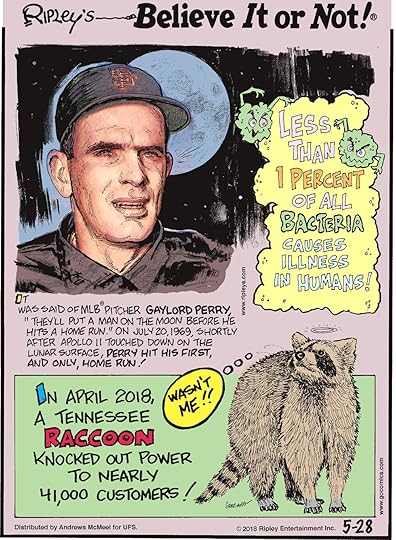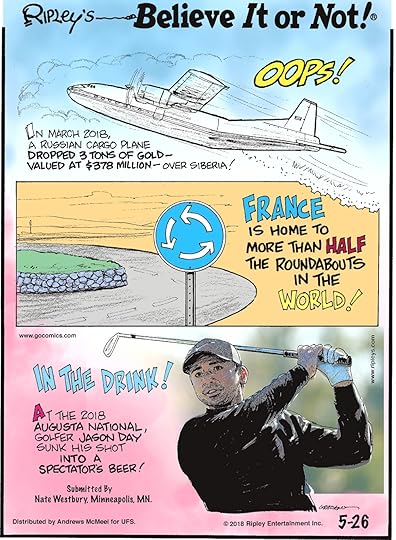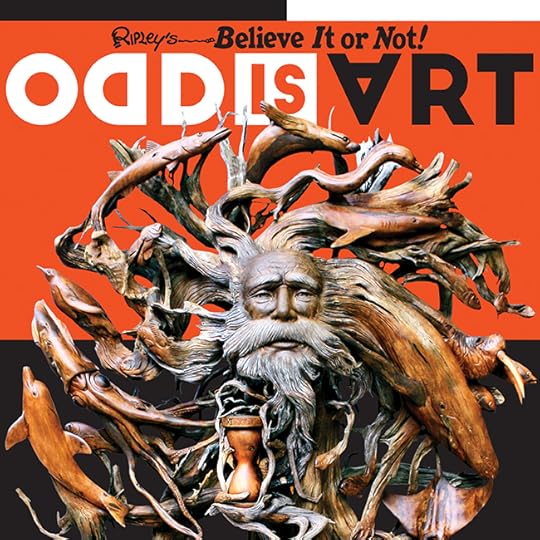Ripley Entertainment Inc.'s Blog, page 341
May 29, 2018
Penis Sheath From The Forests Of New Guinea
Featured in Ripley's Believe It or Not!
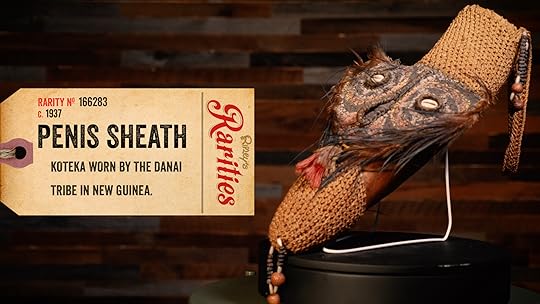
Within the Ripley collection of rare artifacts and curious treasures are a few oddities that would make some of us blush, but as our Vice President of Exhibits and Archives explains, there’s nothing funny about penis sheaths from New Guinea.
Penis sheaths are called koteka locally and have nothing to do with sex as many of our Odditorium guests might assume, but instead simply protect male tribesmen from the vexing bites of insects in the dense jungles of New Guinea.
Koteka are worn in the Dania tribe, and just like a person might have a number of hats, pants, shoes, or shorts; a man in New Guinea may have a vast wardrobe of penis sheaths to choose from.
The sheaths themselves were either made from gourds, woven materials, or a combination of both. Some were plain, but others are ornately decorated with paint, feathers, and cowry shells—much like other artifacts from New Guinea.
The gourds used in koteka-making are specially grown near the houses of villagers so they can be constantly monitored. If a long, straight gourd is desired, they’ll even tie stones to the plant as it grows, carefully molding it into the desired shape.
Despite their apparent lack of lascivious intent, the Christian sensibilities of visiting tourists to the island of New Guinea have long made koteka inherently interesting to outsiders. Penis sheaths have been exotic souvenirs for close to 100 years now, and the tradition itself is slowly disappearing.
It wasn’t until the 1960s that we learned much about the tradition, as British anthropologist Karl Heider spent over two years studying them. He noted that the koteka weren’t just for protection, but were also incorporated into their language. The loud sound of their nails flicking their gourd was sometimes used to communicate messages, ranging from fear to excitement.
Believe it or not, some tribesmen even used empty spaces in their penis sheaths to store money or tobacco. Despite cold conditions and even snow, many Danai continue to just wear their koteka, affording them little pocket space.
CARTOON 05-29-2018
May 28, 2018
The Uncanny Case of the Jim Twins, Two Estranged Twins Who Led Identical Lives
Featured in Ripley's Believe It or Not!

The Jim Twins of Ohio were reunited at age 39, after being separated at birth. When they got to talking, they found that they had lived identical lives!
So Far Apart, Yet Always Together
So, nature versus nurture debaters, what do you make of this one? When two twin boys were put up for adoption in 1940, at only three weeks old, their adoptive parents coincidentally named them both James. Both men came to be named Jim for short, and that was just the start of it. The two would grow up only 40 miles apart from each other, and go on to live lives that were spookily similar.
One of the boys was adopted by the Lewises of Lima, and the other by the Springers of Piqua. Both families knew that the child they adopted had a twin, but did not know what became of them. From there, though their paths had diverged, they unknowingly forged lives as identical as their DNA.
Both had beloved childhood dogs named Toy, and as schoolchildren, both had a proclivity for math and woodworking but were no great shakes at spelling. If their childhoods were uncannily similar, though, then their early adulthoods were truly remarkable.
Twin Hearts, Twin Minds
Both Jims had married twice. The first time, they married women named Linda. When this didn’t work out and they divorced, they met (and went on to marry) women named Betty. Both Jim Lewis and Jim Springer had a son, and –I’m sure you saw this coming—both gave their boy the same name, James Alan (or James Allan in Springer’s case).
Both Jims were heavy smokers, drove the same car (a Chevrolet) and had similar jobs in security (Jim Lewis was a security guard, while Jim Springer had been a deputy sheriff). They even took vacations at the same Florida beach. Neither man knew any of these impossible facts about their brother, however, until Lewis, aged 37, decided to try and get into contact with his twin. In 1977, he succeeded in finding contact details through an Ohio courthouse; the pair spoke on the phone and eventually agreed to meet.

IDENTICAL Twins?
On February 9, 1979, the Jim Twins were finally reunited. When their fascinating case came to light, scientists saw how very valuable they could be to the study of reunited twins. They took part in a study conducted by Dr. Thomas Bouchard of the University of Minnesota, who found that their medical histories and brain-wave tests were almost identical. So too were their results in a personality test.
As First To Know reports, the case of the brothers (and others like them) went on to influence theories of nature versus nurture, and how science thinks about the effects of hereditary over environmental factors. Some have even considered the Jim Twins’ case as possible proof of telepathic connections between twins. Jim Springer did state that he “always felt an emptiness,” after all. Was it his brother he was subconsciously feeling?
By Chris Littlechild, contributor for Ripleys.com
Source: The Uncanny Case of the Jim Twins, Two Estranged Twins Who Led Identical Lives
CARTOON 05-28-2018
May 27, 2018
CARTOON 05-27-2018
May 26, 2018
CARTOON 05-26-2018
May 25, 2018
More Off Limits Places That You Can’t Check Off Your Bucket List
Featured in Ripley's Believe It or Not!

Last week on Cool Stuff Strange Things, we brought to you some the most dangerous destinations and intriguing in the world…that you’ll never get to see for yourself. Back by popular demand: more off-limits places.
It doesn’t matter how much you have achieved. It doesn’t matter how much money you have. There are still some places in the world you cannot check off that bucket list.
The Svalbard Global Seed Vault – Norway
Here, in a site nestled 800 miles from the North Pole and almost 400 feet inside a mountain, lies the 11,000-square-foot Global Seed Vault. Created in 2008 with the thought of global annihilation in mind, the vault holds 840,000 samples of about 4,000 different species of seeds—all in case we humans blow up the world, or Mother Nature decides to do the same, and we need to repopulate the vegetation. Have a seed you want to protect? Just make a deposit. But access is limited to employees only.

Lascaux Caves – France
About 17,000 years ago, humans painted murals of animals, shapes and themselves in the Lascaux Caves in France. But don’t think about going to see their beauty and overall strangeness. Because of several fungal invasions, the caves haven’t been open to the public since the 1960s. Only scientists have been allowed in every few years to study the ancient art.
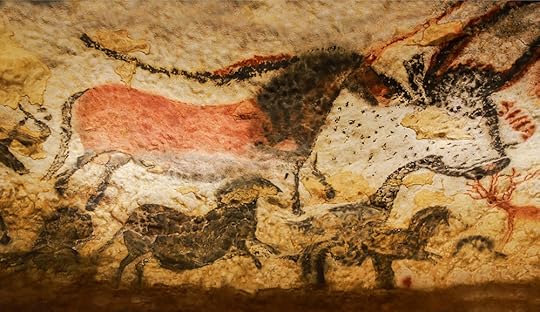
Surtsey Islands – Southern Iceland
Some places are hard to get to for a reason. Take the Surtsey Islands, off the southern coast of Iceland. These islands are relatively young, forming after volcanic eruptions in the 1960s. There, in a tiny hut, are the only humans around—scientists, who are studying how seals and birds colonize new places.
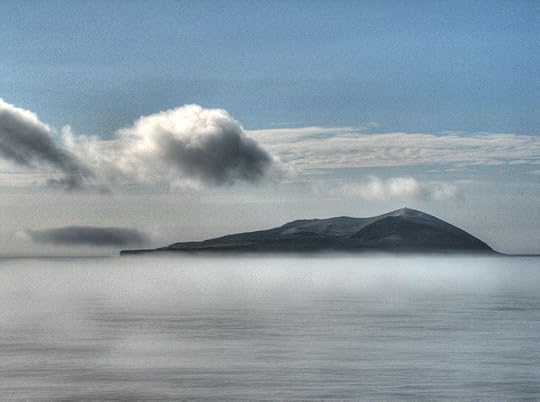
The Jiangsu National Security Education Museum – China
Straight out of a 007 novel, there exists a museum in China that features a history of the country’s greatest spy gadgets. Want to see a tiny camera disguised as a wristwatch? They’ve probably got it there. However, no Westerner can really know because foreigners aren’t allowed in. The exhibits also reportedly explain China’s spy tactics, which we assume they wouldn’t want other countries to know about (if they don’t already).
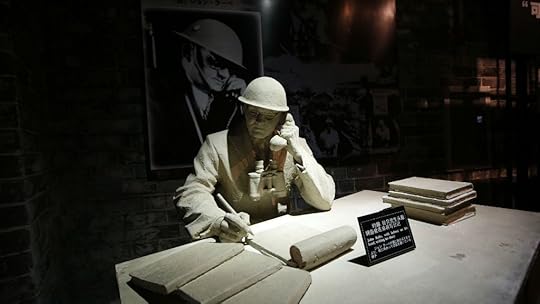
North Sentinel Island – Bay of Bengal
Remember that scene in Indiana Jones where he’s racing to his airplane as he’s being chased by hundreds of spear-wielding warriors? That’s a bit like what you’d face if you went to North Sentinel Island, a heavily forested island in the Bay of Bengal which is home to an undocumented tribe of 50 to 400 people. These folks don’t take kindly to visitors, and they will drive you away with bows, arrows and rocks. In 2008, two fishermen washed up on their beach only to be killed. Circled by heavy coral, it is difficult for boats to get to the island, which is why it is one of the world’s last communities untouched by modern civilization.
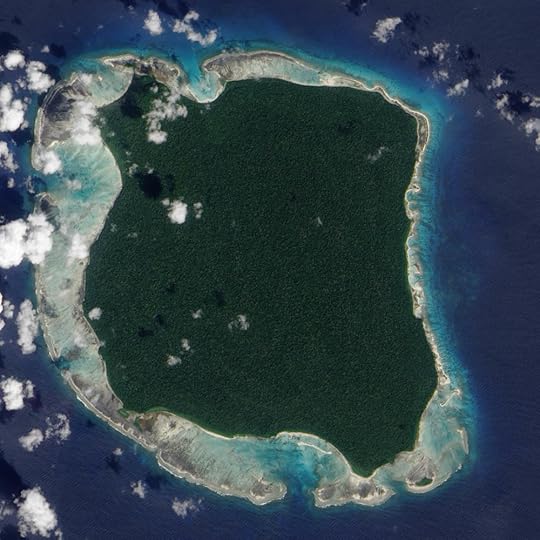
Mount Weather – Virginia
What happens when the world is coming to an end? Well for you and me, it doesn’t make a bit of difference. We’re toast. But for the U.S. Government, they have several places to go to hide out until everything blows over. One of them is Mount Weather, in Virginia, which is designed to hold the civilian leadership of the U.S. government, including the President, the Supreme Court, Cabinet officials, and senior congressional leaders. Originally created as an observatory for the Weather Bureau, Mount Weather now features an underground city that can house thousands of staff. The city has its own sewage treatment, water, fire and police departments, and a bar. Good to know those government people will be cozy when the End Times come.

CC Karen Nutini
Chapel of the Ark of the Covenant – Ethiopia
Remember–don’t look at it directly. The Nazis got really messed up when they did that in Raiders of the Lost Ark. Not that you really have to worry, because you can’t get in to see it anyway, but here goes: In Ethiopia, there is a chapel that supposedly serves as protection for the Art of the Covenant and its contents, the Ten Commandments. Only one monk is allowed in the building to protect it. Once, some workers were let in to fix the roof. But other than that, no one! Still, you can see the building—Saint Mary of Zion in Aksum—or you can wait for one of the times the monks carry a replica through the streets, which they do seven times a month, before sunrise.
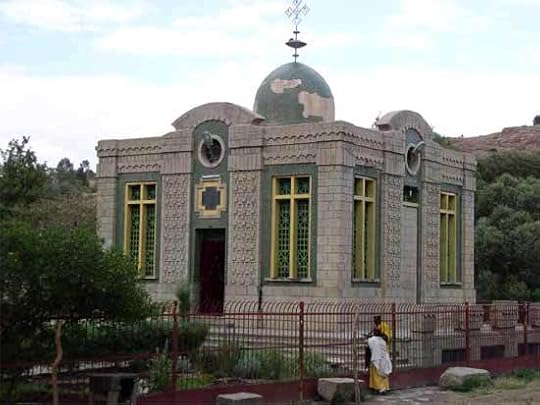
CC Adam Kohn
There you have it! And remember: There is NO way you can see things! Don’t even try!
By Ryan Clark, contributor for Ripleys.com
Source: More Off Limits Places That You Can’t Check Off Your Bucket List
Shipwreck Discovered In Caribbean Could Be Worth $17 Billion
Featured in Ripley's Believe It or Not!

[May 20-26th, 2018] An island where childbirth is outlawed, legal protections for the smell of Play-Doh, and a shipwreck that could be worth $17 billion.
Baby’s Birth Is Illegal
We’ve covered places where dying is banned, but on the tiny island of Fernando De Noronha, giving birth is against the rules. The island sits 227 miles from the nearest mainland city where they can receive proper care. The mother, who has given birth on the mainland before, was unaware of her pregnancy according to officials on the island, and the baby girl is the first child born on the island in 12 years.
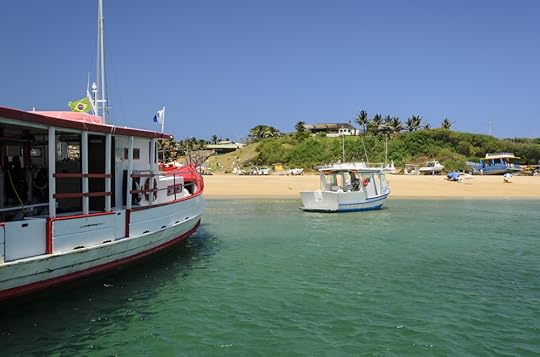
Play-Doh Smell
The United States Patent and Trademarks Office doesn’t usually like to grant trademarks for scents, but Hasbro has successfully gained protection for the smell of Play-Doh. Described as sweet, slightly musky, vanilla-like, and with overtones of cherry; children and parents have been smelling Play-Doh since 1956. Believe it or not, it’s one of only 13 scents protected by U.S. law.

Zombie Alert In Florida
When the power in Lake Worth Florida went out this week, citizens received a disturbing message on their phones: a zombie alert was in effect. The push notification came at 1:45 in the morning along with the outage, panicking some residents but was later retracted by the city.

Coma Caused By Smelling Book
Martin Greenwood was researching his ancestry, combing through hundred-year-old scrapbooks and joke books when he suddenly fell into a six-day coma. Believe it or not, the ancient paper contained spores that caused severe respiratory problems. Despite the multi-month hospital visit, he thinks his ancestors would have found the whole thing pretty funny.

Shipwreck Worth Up To $17 Billion
Over 300 years ago, a Spanish galleon loaded with treasure sank in the Caribbean while fighting off a British ship. The Woods Hole Oceanographic Institution (WHOI) found the wreck in 2015, but the find was kept secret until proper authorities approved a public announcement.

Source: Shipwreck Discovered In Caribbean Could Be Worth $17 Billion
CARTOON 05-25-2018
May 24, 2018
Sunlight Art: Painting With A Magnifying Glass
Featured in Ripley's Believe It or Not!
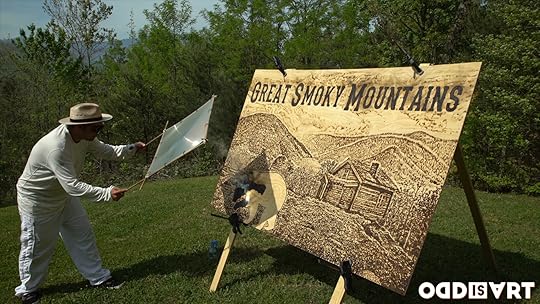
Michael Papadakis uses the largest paintbrush in the world: the sun. In an art form he dubs “heliography,” Papadakis employs a variety of magnifying glasses and reflectors to harness the power of the sun to burn his art into pieces of wood. This sunlight art can be used to make everything from romantic scenes on fence posts to detailed landscapes and cityscapes.
Papadakis was inspired to invent this unique form of art in 2012 while he was traveling the world. Wanting to travel as light as possible, he realized he could use the sun as the ultimate traveler’s paintbrush.
“The idea of painting with the sun presented itself almost naturally to me.”
Completely self-taught, Papadakis developed his art form himself. Constantly experimenting during his 14-month voyage from South Korea to Greece, he refined his artwork using the sunshine local to the vistas and landscapes he was painting.
Heliography literally means the language of the sun, and Papadakis considers his craft to be a way to draw stories out of the sun.
“I am simply holding and redirecting the sun’s power to create art.”
Process
Papadakis has to start at the crack of dawn in order to make full use of the day’s sunlight. He searches for the perfect place to catch the sunshine and inspire him. Typically, he sketches some guidelines on his wooden canvas, then gets to work as the sun rises. Though he can use sunlight all throughout the day, he finds when the sun is low in the sky is optimal. Seasons don’t really matter, and he even prefers to work in the winter because temperatures are low and the sun stays relatively low all day.
He uses a variety of lenses and mirrors to control the light. Some are so focused that he can use them from 15 feet away. Because he’s burning his medium, he keeps a spray bottle handy to control the flames and keep everyone safe, but his most important safety device is his welding shades.
“Sunglasses are not enough.”
The light he’s focusing on his work is so intense that even the reflection is enough to cause eye damage. Dark welding shades are a must, and allow him to focus on what he’s doing. When he paints in public places, he even brings a few extra pairs just in case onlookers want to stick around for a while.
Papadakis notes that he can’t pursue his art in a studio, and instead relishes the opportunity to get out and explore the world while he’s creating. We’ll continue watching his travels on Instagram, but you can check out his work along with our growing collection of exceptional artists in our new book, Odd Is Art.
From paintings by an artist with no arms or legs to sculptures made entirely of salt, you’ll find some of the most fascinating and unbelievable pieces of art from the Ripley’s Believe It or Not! collection. Designed as an elegant art book meets the eclectic one-of-a-kind Ripley’s archives and exhibits, Odd Is Art is a visually stunning book that will delight and amaze art lovers and Ripley fans alike.
Ripley Entertainment Inc.'s Blog
- Ripley Entertainment Inc.'s profile
- 52 followers



